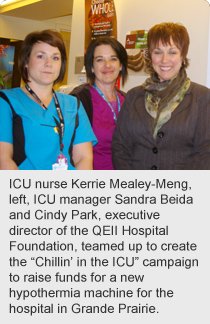
January 2, 2013
Story and photo by Mark Evans
GRANDE PRAIRIE — For some patients, a “cooling off” period is the best medicine.
To those who don’t work in health care, the notion of chilling a patient might seem a tad strange, bordering on science fiction.
But ever since Kerrie Mealey-Meng and a group of her Intensive Care Unit (ICU) colleagues at the QEII Hospital in Grande Prairie got back from a recent critical care conference, they’re excited about the potential to help cardiac patients by lowering their body temperatures.
 “We were actually surprised by how much we did know,” says Mealey-Meng. “There’s a lot we already do on the unit so patients don’t have to be sent out to Edmonton.”
“We were actually surprised by how much we did know,” says Mealey-Meng. “There’s a lot we already do on the unit so patients don’t have to be sent out to Edmonton.”
At the conference, staff members learned that when a patient experiences cardiac arrest, lowering their body temperature reduces the risk of brain damage and loss of life. As the process slows blood flow to the brain, it also allows the body time to flush out toxins that can cause brain damage.
“It affects every system, from head to toe,” says Mealey-Meng.
Typically, nurses on the unit have used fans, ice packs and spray bottles to lower a patient’s temperature. It’s a two-person job that takes several hours to ensure the patient is not cooling too quickly. Then, they can begin to slowly warm the patient to get the health benefits of the process.
But cooling can be achieved much more precisely with hypothermia machine, which uses IV lines to cool, and then warm a patient in a controlled manner — which ensures patients will enjoy the maximum therapeutic benefits.
“You have no control using ice packs,” says ICU manager Sandra Beida. “With the hypothermia machine, it cools them faster and re-warms them exactly 0.2 degrees Celsius an hour.”
A hypothermia machine was already on the unit’s equipment-request list, but Mealey-Meng suggested to Beida that they work with the QEII Hospital Foundation to buy the equipment sooner. ICU staff teamed up with the foundation to launch the “Chillin’ in the ICU” campaign to this end.
On average, one or two patients per month are cooled in the ICU at QEII Hospital. However, recently two patients required cooling the same week. Mealey-Meng says she expects that once the equipment is in place, there will be more opportunities to help patients who require induced hypothermia.
The ongoing campaign kicked off last summer with a book fair and donation forms are currently available at the hospital.
“What I’m most excited about with this campaign is we are working with staff to achieve a common goal,” says Cindy Park, Executive Director of the QEII Hospital Foundation. “It gives us the thought we can accomplish anything for our patients.”